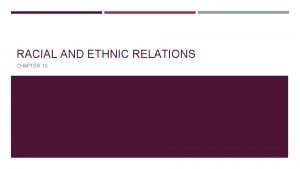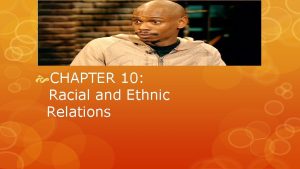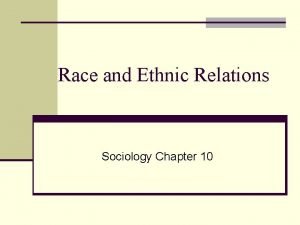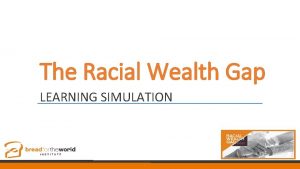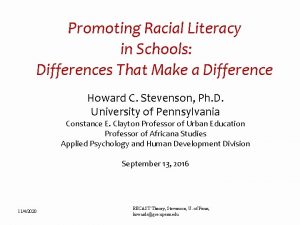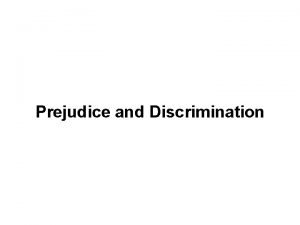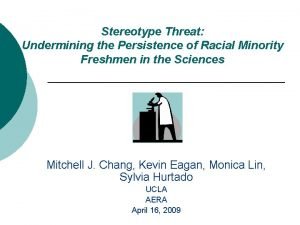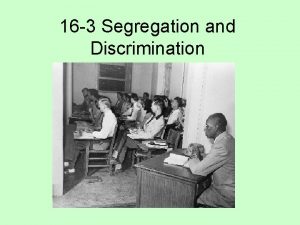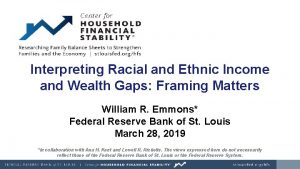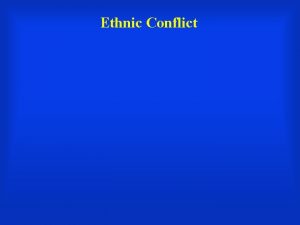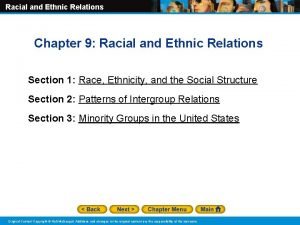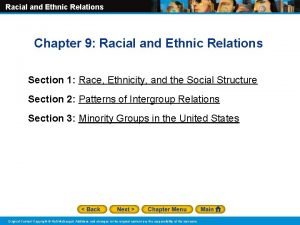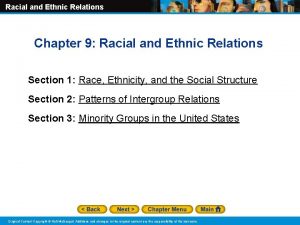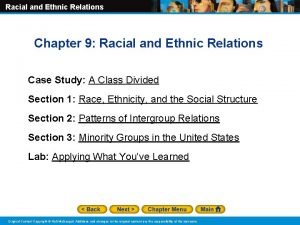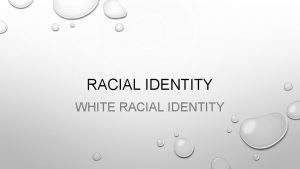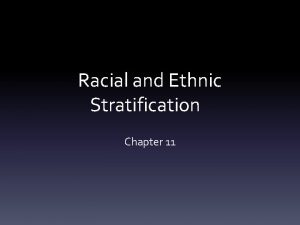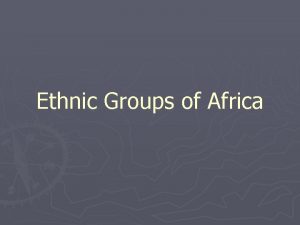Interpreting Racial and Ethnic Income and Wealth Gaps
















- Slides: 16

Interpreting Racial and Ethnic Income and Wealth Gaps: Framing Matters William R. Emmons* Federal Reserve Bank of St. Louis March 28, 2019 *In collaboration with Ana H. Kent and Lowell R. Ricketts. The views expressed here do not necessarily reflect those of the Federal Reserve Bank of St. Louis or the Federal Reserve System.

Interpreting Racial and Ethnic Income and Wealth Gaps: Framing Matters § Income and wealth data from the Federal Reserve’s Survey of Consumer Finances § The importance of framing − The “post-racial” model of income and wealth − A model that allows structural, systemic and other unobservable factors to matter § Application: Does higher ed level the playing field? 1

The Demographics of Wealth Series 2018 Series § HFS essay series links income, wealth and other socio-economic outcomes to a family’s: − Race/ethnicity − Education (own and parents’) − Age and birth year. 2015 Series § www. stlouisfed. org/household-financial-stability/ Your race/ethnicity, education and birth year are strong predictors of your adult outcomes. 2

Black & Hispanic Income Gaps Closing Slowly White level § Data from the Federal Reserve’s Survey of Consumer Finances. § Typical (median) income of black and Hispanic families has moved closer to that of white families but remains 40% lower. § The typical “other-race” family (mostly Asian) has surpassed the typical white family’s income. 3

Racial/Ethnic Wealth Gaps Larger than Income § Black-white median wealth gap in 2016: -90% Racial/ethnic wealth gaps in 2016 vis-à-vis the median/typical white family are much wider than income gaps − Black families (-90%) − Hispanic families (-87%) − Other families (-39%) 4

Racial/Ethnic Wealth Gaps Very Persistent 100 White level § Relative wealth of typical black and Hispanic families has improved a bit since 1989, but the gaps remain close to 90 percent. § Other nonwhite families’ wealth remains below typical white family’s, despite higher income. 5

Two Ways to Interpret Large, Persistent Racial and Ethnic Income and Wealth Gaps § The standard “post-racial” model: Assume that every family faces the same opportunities and choices. − Poor wealth outcomes therefore reflect poor choices. § A model that allows “structural, systemic or other unobservable factors”: Assume that peer groups and context may be just as important as individual choices. − Poor wealth outcomes may reflect poor opportunities. 6

Application: Does Higher Ed Close Wealth Gaps? § Analyze racial and ethnic wealth groups using Model 1. − Reference group is families of white 2 - or 4 -year college grads. − Control for differences in age, education, family structure, financial/balance-sheet characteristics, health, inheritances. − How much of the racial/ethnic wealth gap remains “unexplained”? 7

1) If Everyone “Copied” White College Grads, What Would the Racial Wealth Gaps Be? § The “post-racial” model is standard in economics. § Assumes everyone can/should mimic the financial, familial, health and inheritance patterns of the reference group. § If race doesn’t matter, predicted wealth is same for all groups within an education level; RWG=0. Reference group 8

1) If Everyone “Copied” White College Grads, What Would the Racial Wealth Gaps Be? Average black-white wealth gaps in all survey years, by education § Yes, gaps are lower after “controlling” for different choices (financial, familial). § But racial and ethnic wealth gaps are not zero. § The “residual” race effects are largest among blacks. § The residual race/ethnicity effects are largest among post-graduate degree holders. -40% -21% Reference group -19% -22% 9

Application: Does Higher Ed Close Wealth Gaps? § Analyze racial and ethnic wealth groups using Model 2. − Reference groups are white families of a given education level. − Calculate age/race-specific means for all “control variables. ” − Define individual choices as difference between actual level and own peer group’s average level in each year. − How much of the racial/ethnic wealth gap remains “unexplained”? − These numbers are estimates of the structural/systemic/ unobservable wealth gaps due to race or ethnicity. 10

2) What If Your Agency Is Defined as Differences from Group Averages or Norms? § This is a model in which structural, systemic and other unobservable factors related to race or ethnicity are assumed to define where individual agency begins. § Compare within ed levels. § Model isolates maximum gap that could be due to race-related factors. Reference groups 11

2) What If Your Agency Is Defined as Differences from Group Averages or Norms? § Average black-white wealth gaps in all survey years are very similar across education levels. § Black-white gaps generally are the largest. § Conclusion: Vast majority of the “raw” (-90%) wealth gap is due to “betweengroup” rather than “withingroup” differences. Reference groups -74% -71% -72% -76% 12

Summary of “Interpreting Racial and Ethnic Income and Wealth Gaps: Framing Matters” § Racial and ethnic income and especially wealth gaps are very large and very persistent. § How we interpret the gaps depends on framing. − The standard “post-racial” model of income and wealth blames “poor choices. ” − A model that includes structural, systemic and other unobservable factors points to “poor opportunities. ” § Higher ed cannot overcome vastly different starting points. 13

References § Does College Level the Playing Field? Racial and Ethnic Differences in Family Wealth Among College-Educated Families. A Research Symposium. May 25 -25, 2016. Link. § Emmons, William R. ; and Noeth, Bryan J. “Race, Ethnicity and Wealth. ” The Demographics of Wealth, February 2015, Essay 1, Link. § Emmons, William R. ; and Ricketts, Lowell R. “College Is Not Enough: Higher Education Does Not Eliminate Racial and Ethnic Wealth Gaps. ” Federal Reserve Bank of St. Louis Review, First Quarter 2017, Vol. 99, No. 1, pp. 7 -39. Link. § Emmons, William R. ; and Ricketts, Lowell R. “College Inadvertently Increases Racial and Ethnic Disparity in Income and Wealth. ” In the Balance, February 2017, Issue 16. Link. § Emmons, William R. ; Kent, Ana H. ; and Ricketts, Lowell R. “The Financial Returns from College across Generations: Large but Unequal. ” The Demographics of Wealth 2018 Series, February 2018, Essay 1, Link. 14

Connect With Us Newsletter STLOUISFED. ORG/HFS 15
 Chapter 10 racial and ethnic relations review worksheet
Chapter 10 racial and ethnic relations review worksheet Chapter 10 racial and ethnic relations
Chapter 10 racial and ethnic relations Chapter 10 racial and ethnic relations review worksheet
Chapter 10 racial and ethnic relations review worksheet Racial wealth gap simulation
Racial wealth gap simulation Value added approach
Value added approach Journal entry for revaluation of assets
Journal entry for revaluation of assets What is included in statement of comprehensive income
What is included in statement of comprehensive income Deferred tax asset journal entry
Deferred tax asset journal entry Black studies and the racial mountain
Black studies and the racial mountain Jim crow laws in what region or regions did it exist
Jim crow laws in what region or regions did it exist Promoting racial literacy in schools
Promoting racial literacy in schools Racial theories apush
Racial theories apush Racial prejudice
Racial prejudice Dr. tiburcio de espadana
Dr. tiburcio de espadana Racial insults
Racial insults In what regions did the literacy test exist
In what regions did the literacy test exist Cartel ley organica contra la discriminacion racial
Cartel ley organica contra la discriminacion racial
